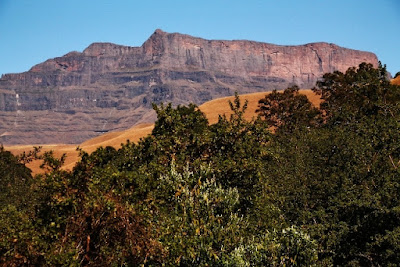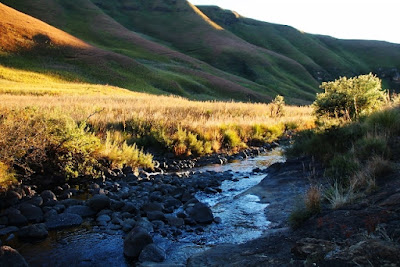Quathlamba
This blog is all about the Drakensberg Mountains and its Wilderness area, South Africa. I have lost my heart and soul to this area and every single time I hike these mountains, I stand in awe all over again at this magnificent beauty.
“Listen to the streams as they gurgle from their cradles and you will hear the story of the mountains. You will hear fascinating tales if only you listen! Lie next to a stream and listen to the song of the mountains. The smiling faces of the flowers, dancing in the wind. Venture into the remote valleys or stand on a peak at sunrise or sunset, after snow has fallen, and you will hear a song that you will never forget - the Song of the High Mountain". (DA Dodds)
Hiking adventures, hiking gear reviews, day walks, accommodation, books, articles and photos, all related to these magnificent mountains will feature here.
Should you want to accompany me on a hike, or need some information or advice, please make contact with me. I hope you enjoy the articles.
Please visit the archive for some more interesting stories, photos and reviews.
Please note that all photos on this blog are copyright protected. If you would like to obtain
Photos please make contact with the author, Willem Pelser.
“AROUND MY HEAD A CHILL WIND SENT SHIVERS THROUGH THE
GRASS, THEN LAY DOWN AND DIED.
FAR, FAR AWAY I HEARD A
JACKAL HOWLING AT THE MOON.
THEN IT WAS STILL.”
DRAKENSBERG GIANT’S CASTLE RESERVE
The great basalt
wall of the Drakesberg erupts from the undulating hills of KwaZulu-Natal like a
fearsome giant, trespassing in some gentle paradise. Serrated peaks more than 3
km high pierce the clouds above a wilderness of plateaus, rolling grasslands
and valleys incised by icy streams.
Here in the Giant’s Castle Reserve the Drakensberg reveals itself
as a long wall of rock, dominated in the southwest by Giant’s Castle itself, a 3 314 m mass of
basalt that towers above the rest.
The brooding presence of this peak
inspired fear in the African communities that lived in the valleys below. They
believed that Giant’s Castle’s vicious thunderstorms and unrelenting barrages
of lightning were signs of the mountain’s anger. They believed that you should
never point at the mountain.
Today Giant’s Castle is a
breathtaking beacon that draws visitors from all over the world to the
beautiful reserve at its feet, and to the extraordinary array of walks and
trails that explore some of the finest mountain scenery in Africa. Apart from
its natural splendour, this part of the Drakensberg (Dragon’s Mountain) range
holds one of the richest stores of San Art on the continent.
Giant’s Castle Reserve
covered just 7 000 ha when it was proclaimed in 1903, but additions of land
over the years, including the Injasuthi area, have brought the total area to 34
000 ha.
The reserve is situated in western KZN,
just 63 km west of Mooi River, at the headwaters of the Bushman’s and Little
Tugela Rivers. It is bordered in the west by Lesotho, and ranges in height from
1 300 m to 3 280 m.
From the air the reserve reveals itself
in three distinct levels, ranging through the forested valleys and gorges of
the Lower Berg, the undulating grasslands of the Middle Berg, and the icy upper
reaches of the High Berg, where only the hardiest heaths and shrubs can
survive.
The valleys and gorges are fringed with
luxuriant forests of yellowwood and ironwood, white stinkwood and Cape chestnut
which, in turn, attract a teeming population of riverine birds.
The grasslands are peppered with dense
stands of fynbos and proteas with its attractive flowers.
WILDLIFE
The most commonly seen mammals are the antelope
eland, blesbok, reedbuck, mountain reedbuck and grey reedbuck. Hikers however,
are also likely to see baboons, rock dassies, blackbacked jackals and anyone of
the three mongoose species. Less conspicuous are the nocturnal cats – servals,
African wild cats and caracals.
Hikers should take heed
that reptiles in the reserve include the highly venomous puffadder and berg
adder, as well as the yellowbellied house snake and the spotted skaapsteker.
BIRDLIFE
There are about 174
species of bird at Giant’s Castle, the most prized of which is the bearded
vulture, or lammergeier, whose home range in Southern Africa is exclusive to
the mountainous regions of KZN and Lesotho. You may see these graceful birds
soaring on the thermals above the main camp, or watch them feeding at the
Vulture restaurant, established near Bamboo Hollow, east of the camp. On
Saturday and Sunday mornings between May and September, bones are laid out and
the vultures come down to feast.
There’s also an abundance
of black eagles, Cape vultures, martial, longcrested and crowned eagles,
peregine and lanner falcons, yellowbilled and blackshouldered kites and three
species of harrier.
The grasslands support grass warblers,
francolins, qails and longclaws, while in the forests you may spot one of five
species of owl, woodpecke or robin.
Feasting of the nectar of
proteas which grace the slopes are a procession of multicolored sunbirds, and
the less conspicuous sugarbird. Along the rivers you’ll see the beautiful
malachite kingfisher eyeing the waterways for a tasty morsel, or the longtailed
widow.
The immediate vicinity of the hutted
camp provides ideal birdwatching oppertunities, especially in spring and
summer, when dozens of species start nesting among the undergrowth and trees
and the air is alive with birdsong.
WHERE TO STAY
There are two main hutted
camps: Giant’s Castle Camp in the south, and the Injasuthi Camp on the northern
border of the reserve.
Visitors walking the longer trails that radiate from
Giant’s Castle Camp, may overnight at anyone of the mountain huts. Do enquire
at the reserve reception as the huts are permanently vandalized by Basotho’s
from Lesotho.
LEGACY OF THE SAN
The Giant’s Castle area used to be the exclusive domain of the San, known as hunter-gatherers.
For centuries they occupied the caves and crevices of Giant’s Castle’s mountain
ramparts in summer, vacating these in winter to hunt eland and other antelope
in the valleys.
The San community here is believed to
have numbered no more than a few hundred. The arrival of the Nguni and European
settlers in the 19th century seriously threatened the livelyhood of
the San and eventually they were decimated.
However, they left behind a rich legacy – more than
50 known sites and 5000 individual examples of San rock art. The best places to
view these paintings are at Main Caves, where there are 546 individual
paintings, and at Battle Cave in the Injasuthi Valley, north of the reserve. (750
paintings)
Other artifacts include
metal and stone arrowheads, and bone fragments of animals and the San
themselves.
MAIN CAVES SITE MUSEUM
A former San shelter 2 km southwest of
the rest camp has been converted into a fascinating museum exhibiting lifelike
San models, artefacts of tools and weapons, an open hearth and clothes worn by
the San.
WALKS AND TRAILS
From the Main Camp there are at least 20
lovely day walks, ranging from 3 km to 26 km. Among them are the walks to:
- · Col. Durnford’s Camp, the Main Caves and the Bushman Museum (3,2 km; 2 hrs.).
- · Main Caves Forest (5 km; 2 hrs.). This route passes through a beautiful forest, bypassing San paintings and clear, deep pools. Take your bathing costume with.
- · Bergview Walk (5 km; 2 hrs.). This ramble offers some of the best views of the Drakensberg at Giant’s Castle.
- · Giant’s Castle Pass and Giant’s Castle (19 k; 8 hrs). A fairly tough climb takes you to the edge of the escarpment for breathtaking views of the reserve.
- · Langalibbalele Pass (26 km; 8 hrs). An historically fascinating walk, which takes hikers past the graves of British soldiers and local tribesman who were killed during an engagement at the top of the pass in the Langalibalele Rebellion of 1873.
FISHING
The rivers and streams of the
Drakensberg teem with brown and rainbow trout, and the Giant’s Castle area,
particurlarly the Injasuthi River, is no exception. Fishing permits are
obtainable from the camps and are renewable on a daily basis.
The End.
Safe Hiking.
Willem
Pelser – The Mountain Man
References and Acknowledgements
Photos –Willem Pelser
Wild Places of
Southern Africa – Tim O’Hagen
Compiled by - W Pelser












No comments:
Post a Comment